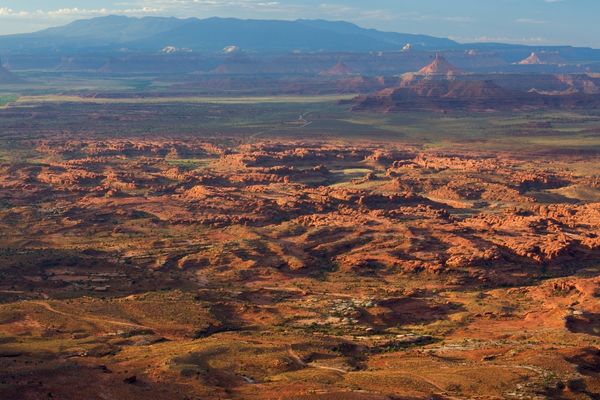
- Details
- By Kaili Berg
On his first day in office, President Donald Trump issued executive orders prioritizing the expansion of fossil fuel and mining development on public lands.
Continuing that approach, newly sworn-in Secretary of the Interior Doug Burgum has signed Secretarial Order 3418, dated Feb. 3, requiring a 15-day review of lands previously withdrawn from resource extraction, including national monuments with cultural and historical importance to Native American tribes.
This directive follows Trump’s 2017 reductions of Bears Ears and Grand Staircase-Escalante National Monuments in Utah by 85% and 47%, which marked the largest rollback of federal land protections in U.S. history.
Unlike that earlier review, which involved public comment, Secretarial Order 3418 does not allow for public input. It also does not directly mention the Antiquities Act, referring to it only by its U.S. code number, despite its role in the designation of many protected sites with tribal significance.
Many of the lands under review are historically and spiritually significant to Native American tribes. Bears Ears National Monument, for example, is sacred to the Navajo Nation, Hopi Tribe, Ute Indian Tribe, Ute Mountain Ute Tribe, and Zuni Pueblo.
The area contains thousands of archaeological sites, including rock art, ancient dwellings, and ceremonial locations. Reducing or eliminating monument protections could lead to increased industrial activity, which may disturb these culturally important sites.
“National monuments can help protect our culture and sacred lands,” Joseph Brophy Toledo, Member of Jemez Pueblo & Tribal Spiritual Advisor, EarthKeepers 360 said in a press release. “ It's important we continue to preserve wildlife habitat protected by our national monuments and be strong in speaking up for the four-legged, finned, winged and micro-invertebrates.”
The review could also have significant economic and environmental consequences. National monuments and other protected public lands play a crucial role in the outdoor recreation economy, which generates an estimated $640 billion annually and supports millions of jobs.
Many rural communities, particularly in the West, rely on these protected lands for tourism, guiding services, and outdoor industries. If protections are removed, these lands could be opened to oil drilling, mining, and other industrial activities that may disrupt local economies and natural ecosystems.
The authority of the president to designate national monuments has been upheld by the Supreme Court, and both Republican and Democratic administrations have used the Antiquities Act to protect sites of historical and cultural importance.
In the past, legal challenges to monument reductions have been brought forward by tribal governments, conservation organizations, and state officials. Similar legal actions may arise in response to this order.
Tribal governments and Indigenous organizations have consistently advocated for greater involvement in federal land management decisions. The outcome of this review could set precedent for future decisions regarding the status of protected lands with tribal significance.
As the review process moves forward, tribal nations, conservation groups, and legal experts are monitoring developments closely.
More Stories Like This
Native News Weekly (August 25, 2024): D.C. BriefsUS Presidents in Their Own Words Concerning American Indians
Indigenous Actor Elaine Miles Reports Detention by Alleged ICE Agents
Happy Thanksgiving from Native News Online
Coming Up on Native Bidaské: Behind the Animation: Joey Clift Talks “Pow” and Native Storytelling
Help us tell the stories that could save Native languages and food traditions
At a critical moment for Indian Country, Native News Online is embarking on our most ambitious reporting project yet: "Cultivating Culture," a three-year investigation into two forces shaping Native community survival—food sovereignty and language revitalization.
The devastating impact of COVID-19 accelerated the loss of Native elders and with them, irreplaceable cultural knowledge. Yet across tribal communities, innovative leaders are fighting back, reclaiming traditional food systems and breathing new life into Native languages. These aren't just cultural preservation efforts—they're powerful pathways to community health, healing, and resilience.
Our dedicated reporting team will spend three years documenting these stories through on-the-ground reporting in 18 tribal communities, producing over 200 in-depth stories, 18 podcast episodes, and multimedia content that amplifies Indigenous voices. We'll show policymakers, funders, and allies how cultural restoration directly impacts physical and mental wellness while celebrating successful models of sovereignty and self-determination.
This isn't corporate media parachuting into Indian Country for a quick story. This is sustained, relationship-based journalism by Native reporters who understand these communities. It's "Warrior Journalism"—fearless reporting that serves the 5.5 million readers who depend on us for news that mainstream media often ignores.
We need your help right now. While we've secured partial funding, we're still $450,000 short of our three-year budget. Our immediate goal is $25,000 this month to keep this critical work moving forward—funding reporter salaries, travel to remote communities, photography, and the deep reporting these stories deserve.
Every dollar directly supports Indigenous journalists telling Indigenous stories. Whether it's $5 or $50, your contribution ensures these vital narratives of resilience, innovation, and hope don't disappear into silence.
 The stakes couldn't be higher. Native languages are being lost at an alarming rate. Food insecurity plagues many tribal communities. But solutions are emerging, and these stories need to be told.
The stakes couldn't be higher. Native languages are being lost at an alarming rate. Food insecurity plagues many tribal communities. But solutions are emerging, and these stories need to be told.
Support independent Native journalism. Fund the stories that matter.
Levi Rickert (Potawatomi), Editor & Publisher

